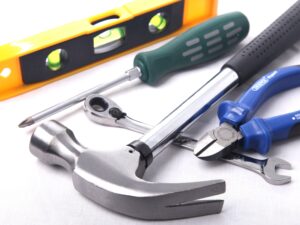You should probably be ready to make a few repairs if you move into this castle. Photo by Flash Alexander
DIY is Important For Renters
First time renters don’t usually think about making repairs. The first time they move out, they might learn that knowing how to Do It Yourself is worth the time and effort.
It is rare these days to rent an apartment, room, or house without paying an upfront security deposit. The deposit is there to ensure the renter doesn’t willfully damage the apartment, and to pay for any damages caused by the renter, whether they were intentional or not.
The building owner is responsible for the general upkeep and maintenance of the building. A tenant should not be charged for replacement of a ten-year-old carpet or for painting the exterior or replacing a worn out roof.
Renters don’t usually make repairs or do maintenance that is the building owner’s responsibility. If something was damaged and it is the renter’s fault, fixing it is their responsibility. But when something breaks and it is not your fault, don’t rush out to buy tools or supplies to repair it. Take any steps to secure your personal property if necessary and call the landlord to have it fixed.
The security deposit protects the owner of the building and ensures that tenants will exercise due care and not willfully cause damage. It also makes sure tenants don’t leave a mess when they move out and clean up the premises.

Even Renters Need Tools Photo
by Scott Liddell
How many people can say they’ve never accidentally damaged something? Perhaps something was spilled a carpet or they accidentally made a dent in a wall while moving furniture. Vinyl floors are usually pretty resilient, but sometimes sliding something heavy across one will put a gouge in it.
When the tenant moves out, the landlord assesses the apartment and charges the tenant for any damages that require a repair. More than likely the landlord will have to pay someone else to do it, and that means full-rate charges for a handyman, painter, or other tradesmen. It doesn’t take a big repair to lose a large chunk of that deposit.
Making a DIY repair to fix the damage could save a lot of money in the end. Not only that, but personal reputation is also at stake. Many building owners and landlords require references, and a former landlord that had to make costly repairs may relate to the new landlord and the tenant is left looking for someplace else.
If your plans include owning your home someday, learning some DIY repairs now will prepare you for the future. You’ll already own a tool belt with a number of tools. Those first repairs you make on your home will seem like a piece of cake because you already have some experience. Experience gives you confidence.
A few tips to get any renter started:
Do a walk-through of the entire apartment or house the day you get the keys. Make sure everything works and note any needed repairs—especially those you are responsible for when you move out. Take video and pictures. If possible, have the landlord walk through with you and note anything that needs repair.
If something breaks and you’re responsible, fix it yourself unless it is beyond your capability. Taking care of it right away helps ensure the return of your security deposit when you move out.
Invest in quality tools. Cheap tools break easily and can cause injury when they do. That doesn’t mean you need a contractor grade tool chest. Look for name-brand tools and avoid the giant tool set in a box that is probably filled with stuff they couldn’t sell otherwise.
Always think long term when you’re buying tools or supplies. A utility knife is great, but three blades won’t last long and a dull blade isn’t much better than no blade. Keep at least ten on hand. Equip your battery drill with packages of the most common screwdriver tips and drill bit sizes instead of going for the big box set with a gillion and seven things no one ever uses.
A Renter’s DIY Home Repair Story
(based on a true story)
Jamal and Nia had a nice third floor apartment with a big kitchen, living room and dining room, a large master bedroom and a smaller guest bedroom. While sweeping the kitchen floor, Jamal noticed a tear in the vinyl flooring and pointed it out to Nia. The next day, Nia called the apartment manager who came up to look at the floor.
“Did you move your table without lifting it up?” she asked. “That kind of repair can be expensive and it wasn’t damaged when you moved in. We usually do repairs like this after you move out.”
After the manager left, Jamal and Nia realized that the repair cost would probably come out of their deposit. Neither one was happy about it, but what could they do?
Just before move out day, Jamal spent a Saturday morning filling a few nail holes with spackle and adding a touch of paint that the hardware store matched for him. The repairs were invisible and once the apartment was painted after they moved out, no one would know they were there.
The utility closet had the same vinyl floor as the kitchen. Behind the furnace and water heater was a piece that was loose. Jamal cut some off with his new utility knife and carefully matched the pattern with the one on the kitchen floor, then he cut out the torn piece and fit the patch into it. A little glue, some pressure, and the repair was virtually impossible to see.
After their rented truck was packed, the manager came up to walk through the apartment. In the kitchen, she looked at the floor where the tear had been, but there was no tear to see. Jamal had fixed it. The young couple got the entire security deposit back after they moved out and left the apartment in better shape than when they moved in.
